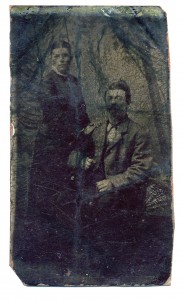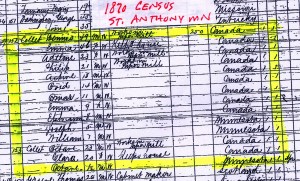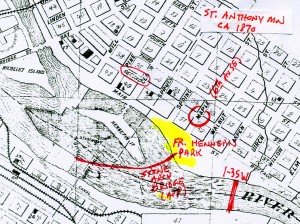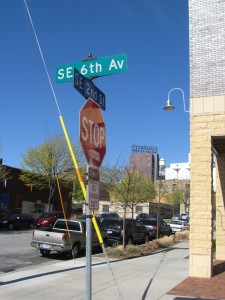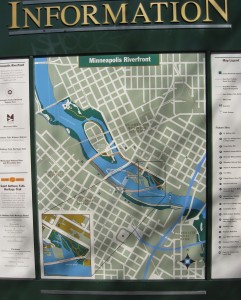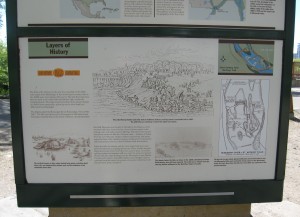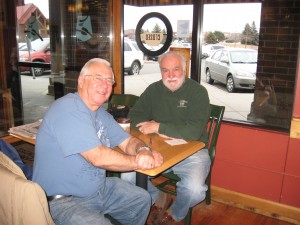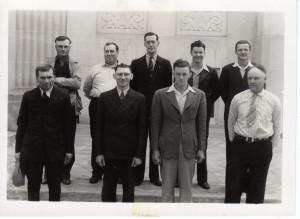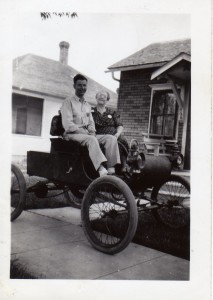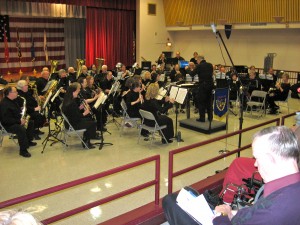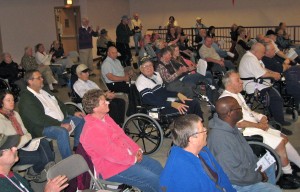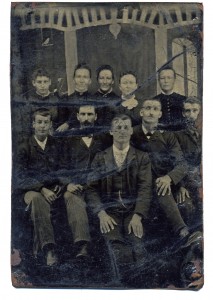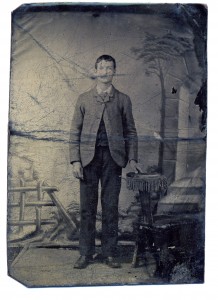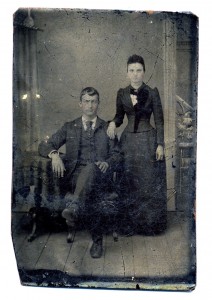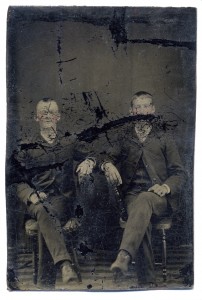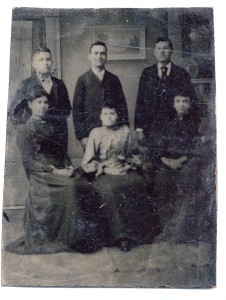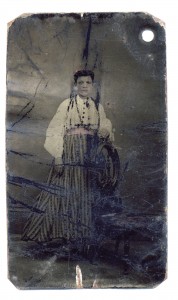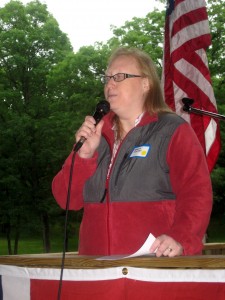SEVERAL UPDATES, INCLUDING PHOTOS at end of this post.
I’m at the age where death is an increasingly regular visitor to my circles. This Memorial Day three deaths come to mind.
The first came when I was 1 1/2 years old, when my Uncle Frank Peter Bernard went down on the USS Arizona at Pearl Harbor HI. He was 26 years old, and I had “met” him in Long Beach CA five months earlier, at the end of June, 1941.
(click on photos to enlarge them)
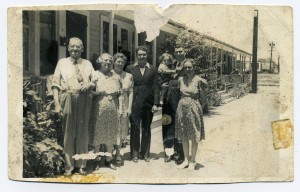
Henry Sr, Josephine, Josie, Frank Peter, Richard, Henry and Esther Bernard, Long Beach CA late June, 1941
I’m the family historian, and I recall no talk, ever, about any kind of funeral or memorial service for Frank.
He was from Grafton, ND. On Dec. 7, 1941, his brother, my Dad, was a teacher in the rural ND country school called Rutland Consolidated; his sister lived in Los Angeles; and his parents were wintering in Long Beach CA. Indeed, according to my Dad, they were not sure, for some time, whether or not Frank was dead. His good boyhood and Navy friend, John Grabanske, was reported to have died, though later was found to be very much alive (and lived on, well into his 80s). Here’s my Dad’s recollection, as recounted by myself 50 years after Pearl Harbor:
Bernard H Pearl Harbor001
The closest I have to a “memory card” about a formal remembering of Uncle Frank is a long article in the February 17, 1942 Grand Forks (ND) Herald, reporting on a large ND picnic somewhere in the Los Angeles area on about February 12, 1942. Such picnics were common in those days – a gathering of winterers and transplants.
There is a poignant passage which I quote here in part: “A touching incident occurred during the program. [The counsel for the Republic of Poland in Los Angeles] read a press report telling of the death of a young man of Polish descent at Pearl Harbor, the young man being a native of the Grafton area. When he had finished reading a man and his wife arose in the audience, the man asking if he might interrupt for just a moment…the man [my grandfather] said the report of the boy’s death later was found to be in error, but that the man actually killed at Pearl Harbor was the pal of the boy mentioned in the first press report. “The boy killed,” said the man, “was our son!”…The entire audience arose and stood in silence for a moment in honor of the dead hero and the parents who made the sacrifice.”
Uncle Frank’s grave, on the USS Arizona, is probably among the most visited cemeteries in the world. I know his sister, my Aunt Josie, visited there in 1969, but my Dad and his parents never had that opportunity.
The next funeral I remember is for that same Grandfather of mine, who died May 23, 1957 at age 85. I was 17.
His funeral was in Grafton, on May 25, 1957, and many people came to his funeral.
Grandpa was a Spanish-American War Veteran, Philippines, 1898-99. We still have the flag in recognition of his service.
It has 48 stars. Alaska and Hawaii had not yet been admitted as states. It is the flag we raised on a flagpole the family purchased at Our Lady of the Snows, Belleville IL, after Dad died in 1997. We raised the flag on Memorial Day, 1998, dedicating it to Grandpa’s sons, my Dad and Uncle Frank. (
Here’s an interesting piece of research about percent of Americans who actually serve in the Military)
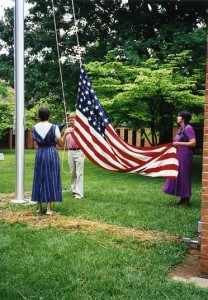
Dedication of flagpole with Grandpa Bernards 48 star flag, Memorial Day, 1998, Our Lady of the Snows, Belleville IL
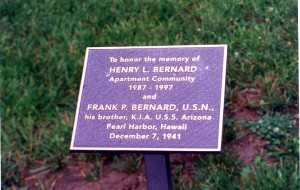
Plaque for the Our Lady of the Snows flagpole, 1998
Time passes on, many more deaths and remembrances of all assorted kinds.
The most recent came on May 19, 2012, in Langdon ND, a memorial service for my cousin Patricia (Brehmer) Krom. Pat actually passed away in Las Vegas on January 25, and there was a memorial service there at that time, but the Langdon area was her home, and my Uncle Vince and I went up for the Memorial Service.
All funerals are alike; all funerals are very different. Pat’s was no exception.
I doubt I will ever forget the eulogy at Pat’s Memorial, given by her husband of 42 years, Kent.
He retraced two lives together in a truly memorable way, one which any one in any relationship for any length of time could immediately relate to; from the first awkward dance at Langdon High School, to her death at only 62 years of age.

Pat Brehmer Krom's life, May 19, 2012
The details are unimportant, except for one which I will always remember. As I recall it, regardless of how their day might have gone, it was a frequent occurrence for exchange of a simple expression of affection: “I love you Kent Krom”; “I love you Pat Brehmer”.
Can’t get better than that.
Arriving back in LaMoure, before I left for home, I picked up a new flag for the flagpole at Vince and Edith’s residence, Rosewood Care Center.
Friday, May 25, at 10:30, they dedicated the new flag to the memory of Patricia Brehmer Krom.
Happy Memorial Day.

Spring at Redeemer Cemetery near Dresden ND May 19, 2012 near the grave of Mary and Allen Brehmer
Memorial Day, which began as
Decoration Day in post-Civil War times, has a long history. Ironically, it was born of what was likely America’s deadliest war ever (in terms of casualties related to the entire population). Americans slaughtered other Americans.
Here are some impressions of today received from individuals. Possibly because the day has an over 140 year history, and because the means of war has changed so much in recent years, making war almost impersonal (see the Pew Research above), there are differing interpretations of what Memorial Day means: is it an event to be solemnly remembered, enjoyed, celebrated, etc.?
How we look differently at the meaning of Memorial Day is good reason for increased conversation among people with differing points of view.
From Susan Lucas: Dick, at the end of your blog you say, “Happy Memorial Day.” I’m afraid I don’t find this day a happy one. The three flags represent our three sons. I’m just so sorry that so many in our society regard Memorial Day as the first day of summer and a three-day weekend to go to the cabin. Anyone who visits Fort Snelling or any other national cemetery can truly appreciate why we have a Memorial Day. While Tom did not die while actually in the service, as the original “Decoration Day” was meant to be, the day should honor all who have been in military service. It’s a day to honor their memory. I question whether it should still be a national holiday when, as Pew Research suggests, so few families are actually impacted by military service anymore.
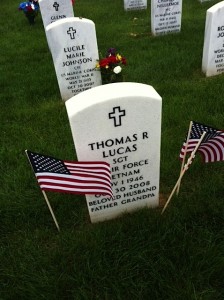
May 27, 2012, at Ft. Snelling Cemetery from Susan Lucas
Beautiful!
Scouts observing Memorial Day at a Cemetery in South St. Paul MN, doing upkeep of graves, and placing flags at the stones of veterans.
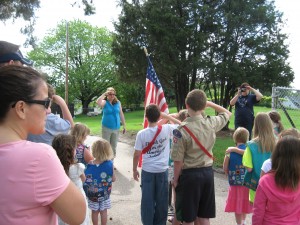
Scouts at So St Paul cemetery May 28, 2012
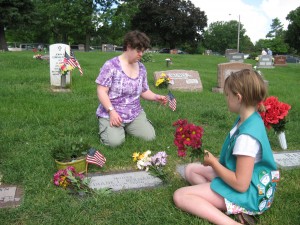
Daughter Heather and granddaughter Kelly at grave of Mom and Grandma Diane in So. St. Paul May 28, 2012
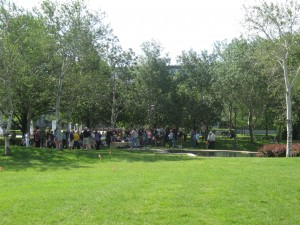
Veterans for Peace near MN Vietnam Vets Memorial on the MN Capitol Grounds May 28, 2012

Local VFP President Larry Johnson at the MN Capitol area observance May 28

Gita Ghei, whose father was caught in the conflict in western India (a civil war of sorts) at the time the British transferred authority to Indians.

Vet Jerry Rau performs a composition on May 28
Commentary
here from Digby related to a Veterans for Peace event in southern California.
Other commentaries on the label “hero” as a topic of contemporary political warfare are
here and
here.
Of course, such a term is a moving target. In the 2004 Presidential Election, candidate John Kerry, whose military service and heroism in Vietnam was ridiculed by “Swift Boating” negative ads, was made to seem the opposite of what he was: a serviceman who had done his job above and beyond the call of duty. I agree with the assessment that the word “hero” is often misapplied in todays political conversation. Personally, I’m a lucky Vietnam era veteran. I served during the first Vietnam War years 50 years ago, and can prove it. I did everything I was asked to do, and I never left the United States. Indeed, we were preparing a reactivated infantry division for later combat in Vietnam, but in our frame of the time, we had no idea that such a war was developing. We simply did our jobs. If that is heroism, so be it.
But, then, John Kerry was far more a hero than I every thought of being, and he was viciously ridiculed for his service….
President Obama spoke at the Vietnam Memorial on Monday. I had the lucky privilege of having been at that Memorial the very weekend it was dedicated in the Fall of 1982.
Vietnam Mem DC 1982001
A little photo album of my service time as a “hero” at Ft. Carson CO can be found on the internet, here. Note my name in the first paragraph, click on the link to the album, and open the link to a few of my “Photographs of 1/61….” in 1962-63.















